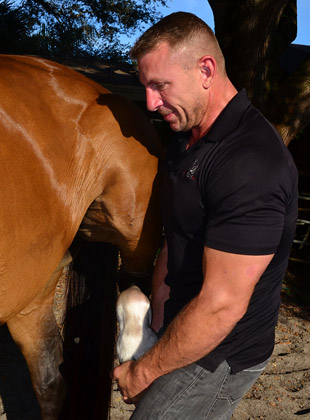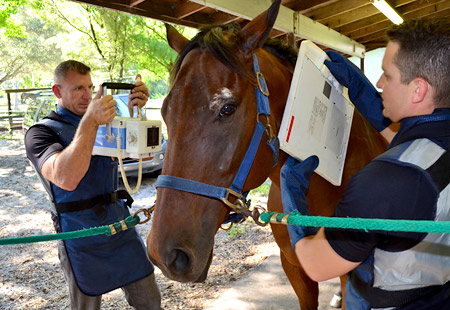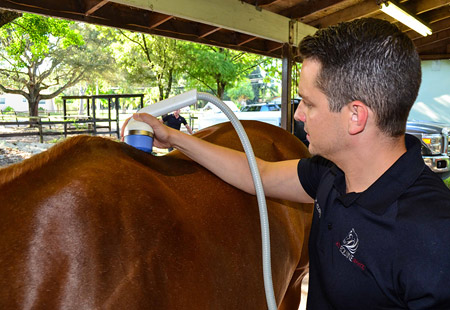Equine Sports Medicine
 Performance and Lameness Evaluations
Performance and Lameness Evaluations
If your horse is not performing at their peak level, a thorough performance evaluation will identify the root causes before they become serious issues. If your horse has an abnormal gait, it is considered lame. Lameness can be caused by structural or functional disorders of the limbs or spinal column and can be observed while the horse is moving. Even a standing horse may offer clues that there is a lameness issue.
Should your horse exhibit indications of lameness, we can provide comprehensive lameness evaluations to determine the cause and identify possible solutions. Evaluations include a thorough history, physical exam, flexion tests and movement observation. Additional diagnostics may include nerve and/or joint blocks, radiographs, ultrasonography, neurological exam and under saddle observation.
Once the location, nature and extent of the problem is determined by our veterinarian, we will tailor a course of treatment most likely to heal your horse and allow him or her to return to regular activity. We offer a range of treatments, including (but not limited to):
- Stem Cell Therapy
- Shock Wave Therapy
- Anti-Inflammatory Therapy
- Antibiotics
- Intra-articular (joint) Medications
- PRP Therapy (platelet enriched plasma)
The key to solving your horse's lameness is often a methodical approach, which allows us to accurately identify the source and causes. Our equine veterinarians have a great deal of experience with lameness and performance problems, treat each case individually, and take pride in a successful outcome.
Diagnostic Services for Equines
Scott Equine Services has invested in advanced diagnostic technologies, including digital radiography, video endoscopy, ultrasound and a comprehensive in-house laboratory.
A horse with an undetermined illness or injury can be a concerning and stressful situation. Our knowledgeable, skilled veterinarians can provide you the answers you need and an effective treatment plan as quickly as possible.

Equine Digital Radiography
Radiographs, or X-rays, are one of the most common, useful diagnostic tools in medicine. Our veterinarians use radiographs to examine your horse's feet, legs, joints, spine, head and oral cavity. X-rays are an invaluable tool for lameness evaluations. They are also an important tool during performance and pre-purchase examinations. Radiographs assist our veterinarians in uncovering underlying or potential issues before they become a problem. Radiographs are painless, safe, and non-invasive.
Advantages of a high quality digital system include:
- Immediate viewing on a computer monitor.
- The clear, detailed images can be manipulated to generate a better view of your horse's anatomy, leading to a faster, more accurate diagnosis.
- They take less time to process, which means less time and stress on the horse, and less waiting time for you.
- If a second opinion is necessary, digital X-rays can be emailed to a specialist.

Equine Ultrasound
Ultrasound is a painless, safe, non-invasive procedure we use to evaluate your horse's tendons, ligaments, joints and internal organs. Ultrasound can be used as a guide during intralesional stem cell and PRP injections. Using high-frequency sound waves, ultrasound produces a real-time moving picture of your horse that allows us to visualize tissues and structures that cannot be detected by radiographs alone.
An ultrasound can take up to 60 minutes to perform thoroughly and the patient is sedated for the safety of all concerned. A diagnosis is usually available immediately – so we can recommend a treatment plan as part of the examination appointment.

Shockwave Therapy
Shockwave therapy (SWT) is a valuable tool in sports medicine. SWT delivers a focused energy pulse to a specific area of tissue, facilitating the healing process. It may be used alone, or in combination with other regenerative therapies. The treatment is repeated approximately every 10 days during the beginning and early stages of the healing process for several treatments. Some studies have documented a pain relieving effect following shockwave therapy.
